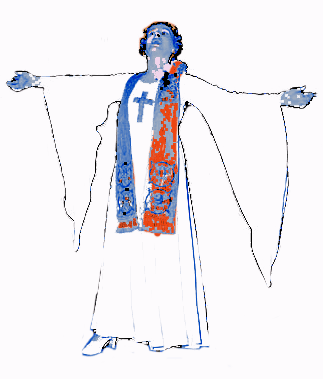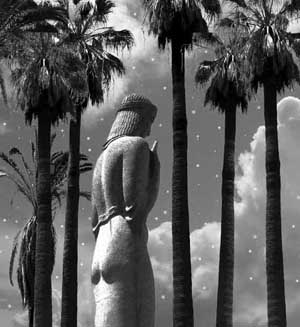THROTTLE by GORDY GRUNDY
Paris in the Twenties. Greenwich Village in the Fifties. Chelsea in the Eighties. Right here, right now, Echo Park in Los Angeles is a mad bonfire of energy and passion, a white flame that can burn no brighter. Throughout modern times, there have been a confluence of factors that empower a creative halcyon, a time and place that becomes greater than itself, for the artistic effluence ripples for generations to come.
The sunlight that falls on Echo Park is golden. A number of factors have created this moment. An economic boom. Rising real estate prices. Hard gang warfare. Poverty. Regentrification. Rent control. And history.
Art by Gordy Grundy
A century ago, the rolling hills and valleys of Echo Park were once considered out of town, in the country. The seclusion fostered a home for wild-minded freethinkers. Communes flourished. Start-up religions, nudist colonies, health food fads and cults called it Ground Zero. So did evangelist Aimee Semple McPherson. Echo Park was also known as Red Hill for its population of Bolsheviks.
Always a working class neighborhood, Echo Park got left behind when Los Angeles moved west toward the sea.
Today, E.P. is still the neighborhood with a few chickens in every backyard. New construction is remodeling the Chevy chassis in every front yard into a living room with French Doors, crown molding and marble floors. Rent control gives the creative shelter but new rents are outrageous, affordable only to the professional. A few new cafes, art spots and homegrown retail stores are creating a walking neighborhood. This morning at coffeehouse Chango, a pal elbowed me in the ribs and exclaimed, “I’ve never seen so many good looking art babes.”
There is a hum to the neighborhood, an energetic breeze that blows through the sharp turns, dead ends and steep climbs of these hills. Echo Park is a concentration of creatives.
John Dentino is a documentary filmmaker struggling to finish ‘Saving Patty.’ The bills are piling up and the credit cards are maxed out in a last push to complete the film. Grants, hard to apply for and harder to get, are not really an option. Nor is commercial funding, for Dentino’s subject matter lacks celebrity appeal. ‘Saving Patty’ follows a cracker barrel of Oklahoma white trash and their addictions. That’s not commercial unless Patty was a pop star. Dentino has floated over the falls with ‘Saving Patty’. The car may get booted but the film will get finished. Somehow. Someway.
Photo Illustration By Gordy Grundy
Keith Niles has no illusions about the poet’s life. He runs the famous open mike at the Little Joy, a local bar that Charles Bukowski would have been proud to hurl in. Niles wants to do a CD for this year’s anniversary anthology. Naturally, the effort will include the work of Buffy Visick playing her battery-powered Mormon Organ and the romance of actor Ben Crowley, but the real coup would have to include Leslie Stevens. Leslie is a songwriter who frequently performs new work at the open mike. Not only is she is wise, witty and soulful, Leslie is breaking out. She keeps pushing her band, Leslie And the Badgers, to the next glorious mile. She’s gonna be famous.
Charles Rappleye was once known as a cop-chasing reporter covering the Rampart Scandal. A short evolution later, he is now a much honored non-fiction historical writer. He is deep into his new book, a biography of Robert Morris the financier of the Revolutionary War. Rappleye is discovering a renewed appreciation for the architects of these United States.
Dave Reeves was just relaxing with buddies, beer and BB guns when he caught his nosy neighbor spying on them with a video camera. Dave, screenwriter, featured columnist in Arthur Magazine and bartender at the Little Joy, did what any hot-blooded Southern boy would do; he gave the trespassin’ ‘Mrs. Kravitz’ a beatin’. Dave and other members of the Kissinjah Militia had been out trail running, an activity favored second only to beer drinking and BB gun target practice.
Dave was too nervous to speak about something big and nerve-wracking in his life for fear of jinxing it. He hopes the screenwriter gig with the primo director falls into place. He’s also worried if it does; Dave has trouble with money. The last time he made big bucks, the sushi, Sallys and sybarites almost killed him.
Dutch photographer Monica Nouwens now lives out in the open. Five years ago she was dodging immigration, but now she has been accepted as an ‘Alien With Extraordinary Abilities In The Arts And Sciences’. It’s never easy for a wetback. She juggles jobs and assignments for architects and art magazines, but it is her students that inspire how she spends her time. She teaches at Sci-Arc and UCI where her students are growing and flourishing. Prowling less of the night with her camera, Nouwens almost prefers to create challenging assignments that are yielding brilliant flowers.
Video artist Dave Burns should have probably been working on promoting his inclusion in the Getty show. His piece ‘Asswax’ is a crowd favorite. Instead he was walking from Machine Projects, the esteemed art space on Alvarado, with a flock of twenty in tow. Burns is one of the founders of ‘Fallen Fruit’, an activist arts project to map public fruit in the hood. The project is getting national attention from the New York Times and NPR.
These are but a few of the many artists, musicians and writers who are lucky to be living in Echo Park right now. The mad nights and late days are as brilliant and lasting as the sunlight that sparkles off Echo Park Lake. These are the times to be remembered. As forces change the environment, the bohemianism of E.P. is soon to be only a treasured memory of history. And so it goes.
GORDY GRUNDY is an Echo Park based artist. His visual and literary work can be found at www.GordyGrundy.com.

